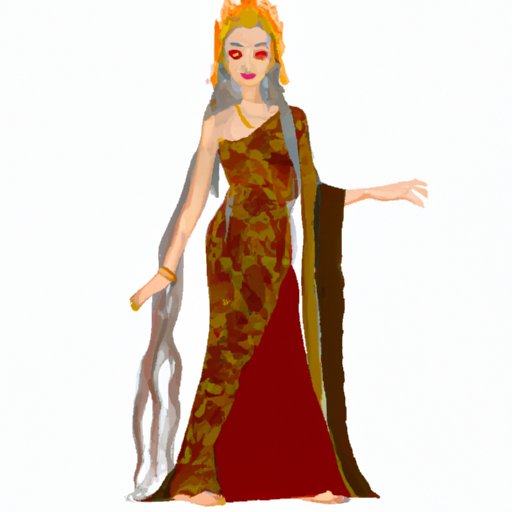
Introduction
When it comes to mythology, few figures are as captivating and complex as the Goddess of Beauty. Since ancient times, people have been fascinated with the idea of beauty as embodied in a divine figure. Whether it’s the iconic Venus of Roman myth or the ethereal Hathor of ancient Egypt, the goddess of beauty has captured the imaginations of people across time and culture. In this article, we’ll explore the world of the goddess of beauty, delving into both its mythology and its impact on society and culture.
10 Things You Need to Know about the Goddess of Beauty
1. The Goddess of Beauty is a common figure in mythology across cultures, known by many names, including Venus, Aphrodite, Freyja, Lakshmi, and Hathor.
2. In many myths, the Goddess of Beauty is associated with love, sexuality, fertility, and desire.
3. The Goddess of Beauty is often depicted as a stunning, youthful figure, with an emphasis on physical beauty.
4. The goddess’s story is told through many myths, but perhaps one of the most famous is the story of Aphrodite and Adonis, which dates back to ancient Greece.
5. Many believe that the goddess’s powers extend far beyond physical beauty, with some believing she has the power to enhance social interactions and overall positivity.
6. Along with beauty, the goddess is often associated with the concept of balance, as it is said that beauty exists in a balance between order and chaos.
7. Some have argued that the goddess’s emphasis on physical beauty can lead to issues like body shaming and unrealistic beauty standards.
8. Despite these concerns, many cultures still celebrate the goddess through various festivals and rituals.
9. The symbol most commonly associated with the goddess of beauty is the rose, which has been used throughout history as a symbol of love, beauty, and balance.
10. Today, the image of the goddess of beauty is often used in marketing, with companies using the idea of beauty to sell products.
Exploring the Mythical Tale of the Goddess of Beauty
One of the most popular myths associated with the goddess of beauty is the story of Aphrodite and Adonis. The story takes place in ancient Greece and tells the tale of Adonis, a handsome young man who is loved by both Aphrodite, the goddess of beauty, and Persephone, the goddess of death. Both goddesses vie for Adonis’s affections, but in the end, it is Persephone who wins. However, before he can leave Aphrodite, Adonis is killed by a wild boar.
The myth of Aphrodite and Adonis is significant because it shows the power and complexity of the goddess of beauty. She is not just a pretty face, but a figure with deep emotions and desires. Additionally, the story shows how beauty and desire can lead to tragedy, as evidenced by Adonis’s untimely death.
The Archetype of Beauty: Examining the Goddess of Beauty in Mythology
The goddess of beauty can be seen as an archetype, which is a universal symbol or representation of a particular concept. In this case, the concept is beauty. As an archetype, the goddess is a representation of the ideal of beauty, which is often subjective and varies across cultures.
There are many other archetypes that relate to or contrast with the goddess of beauty, including the shadow archetype, which represents the darker aspects of beauty, such as vanity and superficiality. Additionally, the mother archetype can be seen as embodying a nurturing, loving version of beauty.
The Influence of the Goddess of Beauty on Society and Culture
The goddess of beauty has had a significant impact on society and culture throughout history. In many cultures, festivals and rituals have been created to honor the goddess and celebrate her beauty. Additionally, the goddess’s image has been used in art, literature, and music to convey ideas of love, desire, and physical beauty.
However, the goddess’s emphasis on physical beauty has also led to issues like body shaming, the promotion of unrealistic beauty standards, and the objectification of women. Additionally, the influence of the goddess on popular culture has led to the commodification of beauty, with companies using images of the goddess to sell products.
Uncovering the Hidden Meanings Behind the Goddess of Beauty’s Symbolism
The symbol most commonly associated with the goddess of beauty is the rose, which has been used throughout history as a symbol of love, beauty, and balance. However, other symbols associated with the goddess include doves, mirrors, and seashells.
The symbolism associated with the goddess of beauty can be interpreted in a variety of ways. For example, the rose can be seen as representing the delicate balance between beauty and pain, as the rose’s thorns represent the potential for harm. Similarly, mirrors can be seen as representing the idea of self-reflection and understanding oneself.
Comparing and Contrasting Different Cultures’ Depictions of the Goddess of Beauty
Despite the goddess of beauty being a figure found in many different cultures, there are notable differences in how she is depicted. For example, in Ancient Greek mythology, Aphrodite is often portrayed as a vengeful, jealous goddess, while in Hindu mythology, Lakshmi is seen as a generous, compassionate figure. Additionally, while many Western cultures place a strong emphasis on physical beauty, other cultures, such as Japan, focus more on inner beauty and self-improvement.
Conclusion
Overall, the goddess of beauty is a complex and intriguing figure in mythology and culture. While her emphasis on physical beauty has led to issues like body-shaming and unrealistic beauty standards, her symbolism and archetypal qualities have allowed for a deeper understanding of the concept of beauty. By exploring the goddess’s mythology, symbolism, and societal impacts, we gain a deeper understanding of the role beauty plays in our world.





